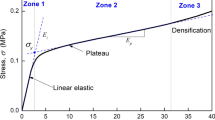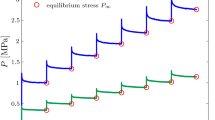Abstract
The mechanical behavior of EPS (Expanded polystyrene) with three densities at room temperature and under tension loading was studied. The results show that EPS material is characterized by brittle behavior in the tension tests, and tensile properties of EPS increase with the increase of density. Volume fraction has no a significant effect on the modulus of these foams. The tensile creep strain increases with stress for EPS with same density, indicating that the creep behavior is of the stress dependency. And the creep behavior of EPS exhibits density dependency, which the creep strain decreases with densities for a fixed stress value. Moreover the creep behavior under the constant tension load is well in coincidence with the three-parameter solid model.
Similar content being viewed by others
References
DUSKOV M. Materials research on EPS20 and EPS15 under representative conditions in pavement structures [J]. Geotextiles and Geomembrances, 1997, 15: 147–181.
THOMPSETT D J. Design and construction of expanded polystyrene embankments [J]. Construction and Building Materials, 1995, 9(6): 403–411.
HORVATH J S. Expanded polystyrene (EPS) geofoam: An introduction to material behavior [J]. Geotextiles and Geomembrances, 1994, 13: 263–280.
BEINBRECH G, HILLMANN R. EPS in road construction-current situation in Germany [J]. Geotextiles and Geomembrances, 1997, 15: 39–57.
GNIP I J, KERSULIS V J, VAITKUS S J. Predicting the deformability of expanded polystyrene in long-term compression [J]. Mech Compos Mater, 2005, 41(5): 407–414.
GNIP I Y, VAITKUS S, KERSULIS V, VEJELIS S. Long-term prediction of compressive creep development in expanded polystyrene [J]. Polymer Testing, 2008, 27: 378–391.
GIBSON L J, ASHBY M F. Cellular solids: Structures and properties [M]. Cambridge: Cambridge University Press, 1997.
KANG Y A, ZHANG J Y, TAN J C. Compressive behavior of aluminum foams at low and high strain rates [J]. Journal of Central South University of Technology, 2007, 14(s1): 301–305.
SIMONE A E, GIBSON L J. The effects of cell face curvature and corrugations on the stiffness and strength of metallic foams [J]. Acta Materialia, 1998, 46(11): 3929–3935.
ZHANG C Y. Viscoelastic fracture mechanics [M]. Beijing: Science Press, 2006.
Author information
Authors and Affiliations
Corresponding author
Additional information
Foundation item: Project(06C243) supported by Scientific Research Fund of Hunan Provincial Education Department, China
Rights and permissions
About this article
Cite this article
Kang, Ya., Li, Xf. & Tan, Jc. Uniaxial tension and tensile creep behaviors of EPS. J. Cent. South Univ. Technol. 15 (Suppl 1), 202–205 (2008). https://doi.org/10.1007/s11771-008-0346-7
Received:
Accepted:
Published:
Issue Date:
DOI: https://doi.org/10.1007/s11771-008-0346-7




